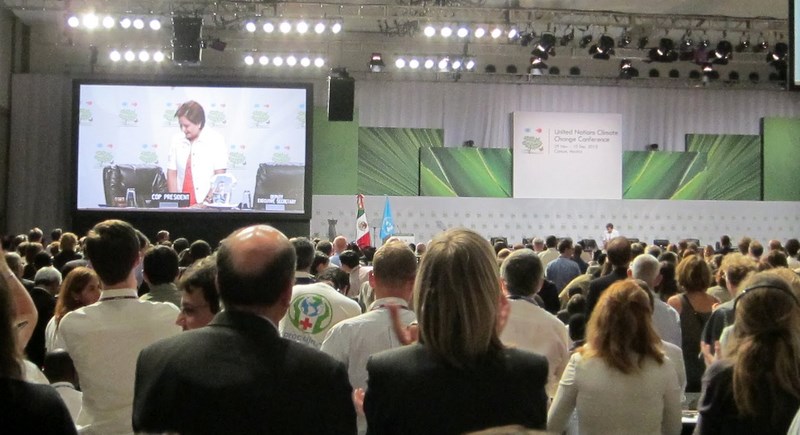 Early Saturday morning, Mexican Foreign Minister Patricia Espinosa gaveled home an agreement by over 190 countries that came together and demonstrated a renewed commitment to the fight against global warming. The Cancun Agreements are a detailed set of visionary yet pragmatic principles that make important strides to begin implementing the agreement reached in Copenhagen last year. The countries gathered in Cancun made progress on emissions reductions, greater transparency, forest preservation, and the creation of the green fund to help mobilize much needed investments throughout the world.
Early Saturday morning, Mexican Foreign Minister Patricia Espinosa gaveled home an agreement by over 190 countries that came together and demonstrated a renewed commitment to the fight against global warming. The Cancun Agreements are a detailed set of visionary yet pragmatic principles that make important strides to begin implementing the agreement reached in Copenhagen last year. The countries gathered in Cancun made progress on emissions reductions, greater transparency, forest preservation, and the creation of the green fund to help mobilize much needed investments throughout the world.
We aren’t done in our battle to address global warming, but these agreements provide a foundation from which to build further action. It does this in four important ways which were essential steps in Cancun.
1. Commitments by countries to take action to reduce emissions. The agreement reaffirms the commitments by countries to implement their specific actions to reduce emissions. In Copenhagen, countries accounting for over 80% of the world’s emissions made specific commitments to reduce their emissions at home. The agreement marks a continued commitment to implement these actions in a country’s domestic laws and policies. For the first time these countries decided to “anchor” their pledges in an agreement adopted by the UN. These are actions that countries are already beginning to take at home, which is ultimately what we need from the international agreement—action, action, action.
2. Improving transparency and accountability. It also contains important decisions that would begin to implement details on how to increase the transparency and accountability of countries emissions and actions. This will provide the necessary data, information, reporting, and scrutiny to keep a spotlight on whether countries are making the necessary progress towards their commitments. The agreement will allow all countries and the world’s citizens to have the needed information to hold countries accountable for their progress.
The decision would require that developed countries improve their monitoring, reporting, and verification (MRV) of emissions, actions to reduce emissions, and financial support to developing countries. Developed countries would continue to submit annual emission inventories which track their economy-wide emissions over time. And they would be required to better track their progress in implementing their emissions reduction actions and financial support to aid developing countries in reducing emissions and adapting to the impacts of climate change. These monitoring and reporting provisions would be subject to enhanced review by technical experts providing a level of assurance that the information is accurate and credible so that there is no “fudging the details.”
The agreement would require that developing countries improve their reporting on emissions and actions that they are taking to cut emissions. They would now report every 2 years their emissions and actions. And these would be subject to domestic monitoring, reporting, and verification “in accordance with guidelines to be developed under the Convention”. The agreement would create a new technical analysis of the information reported by the country through “international consultation and analysis” (ICA). The process for ICA includes the key elements proposed by the Indian’s in advance of the meeting, including a technical analysis of the countries reports and a formal dialogue to discuss the content of those reports (e.g., the emissions inventories, data and assumptions, and information on the countries domestic verification system, etc).
All of these elements provide a platform to give recognition to the countries that are meeting their commitments and a transparent window on the countries that aren’t.
3. Creating a “Green Climate Fund” to help mobilize significant investments in developing countries to address climate change. The elements of the finance deal struck a balance between the need to quickly establish a major fund to move multi-lateral resources efficiently to the developing world, and the need to provide a robust structure that would ensure funds are governed properly. The agreement reaffirms the commitments from Copenhagen to deliver $30 billion in fast start funds through 2012 and to reach a scale of $100 billion a year by 2020. Countries agreed to create a new “Green Climate Fund” which would be structured to ensure that: resources are being efficiently mobilized, countries would have the necessary confidence to mobilize scaled-up resources over time, and the money would be targeted to achieve the “biggest bang for the buck.”
4. Make progress on efforts to reduce deforestation emissions, speed up the deployment of clean energy, and assist developing countries in adapting to the impacts of climate change. The agreement would provide some necessary principals for monitoring, reporting, and safeguards to ensure that the deforestation efforts protect indigenous peoples, biodiversity, and natural forests. And it would begin a more concerted debate on how to scale-up financing to address the major source of global warming pollution associated with deforestation and forest degradation.
It would create “centers and networks” to help developing countries tap into key expertise in their efforts to deploy clean energy. And it would help connect countries to the growing number of financing opportunities. So countries could tap into the growing opportunities to deploy clean energy that are materializing as the “race for the clean energy future” evolves.
The agreement would develop adaptation institutional arrangements to assist the most vulnerable that are already feeling the impacts of climate change. It would provide guidance and direction to further implement a set of targeted efforts to help countries adapt.
On all these issues, our work isn’t done … but some trust has been rebuilt which is essential to our global efforts. Following Copenhagen there was a huge trust deficit which meant that any attempt to make progress was viewed as a trick, illegitimate, or unfair. Making progress internationally on this issue requires that countries collectively want to move forward. They have to move forward not because they are forced to (even though this is ultimately a negotiation), but because they are willing to rise above their differences and find an agreement which begins to solve global warming. They have to be equally satisfied and dissatisfied.
During the negotiations countries need to feel pressed to move from stated positions, but at the end all countries need to look in the mirror and say: “This is the best path forward for the world and my country at the same time”. In Cancun, the mood in the final hours matched
that spirit. Country after country stood up and let their voice be heard that they saw significant promise in the agreement and they would support its adoption by the UN. Countries ranging from the big emitters, most vulnerable, middle income, the developed and developing world, and from all the different regions of the world rose up in those final hours. It was a sight that I’ve never seen in my years in these negotiations.
We’ll need that new spirit to remain as much more work lies ahead. Addressing global warming will require stamina, creativity, and perseverance. Traits embodied in how countries approached the Cancun negotiation session. Let’s build upon those traits and the agreement in Cancun to combat global warming. Time is not on our side, so we must rise above and find the needed solutions.


